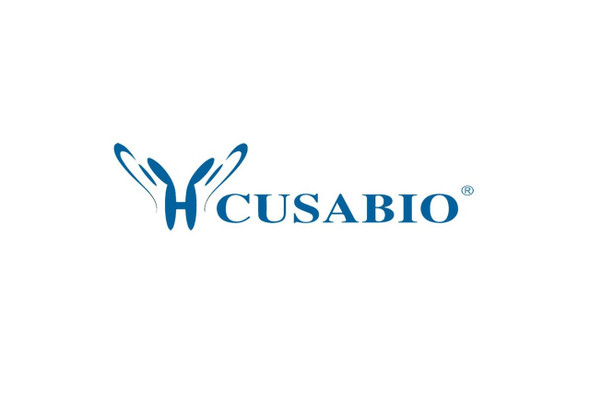Cusabio Human Recombinants
Recombinant Human Frataxin, mitochondrial (FxN) | CSB-EP613687HU(A4)b1
- SKU:
- CSB-EP613687HU(A4)b1
- Availability:
- 3 - 7 Working Days
Description
Recombinant Human Frataxin, mitochondrial (FxN) | CSB-EP613687HU(A4)b1 | Cusabio
Alternative Name(s): Friedreich ataxia protein
Gene Names: FxN
Research Areas: Tags & Cell Markers
Organism: Homo sapiens (Human)
AA Sequence: MWTLGRRAVAGLLASPSPAQAQTLTRVPRPAELAPLCGRRGLRTDIDATCTPRRASSNQRGLNQIWNVKKQSVYLMNLRKSGTLGHPGSLDETTYERLAEETLDSLAEFFEDLADKPYTFEDYDVSFGSGVLTVKLGGDLGTYVINKQTPNKQIWLSSPSSGPKRYDWTGKNWVYSHDGVSLHELLAAELTKALKTKLDLSSLAYSGKDA
Source: E.coli
Tag Info: N-terminal 10xHis-tagged and C-terminal Myc-tagged
Expression Region: 1-210aa
Sequence Info: Full Length
MW: 28.1 kDa
Purity: Greater than 85% as determined by SDS-PAGE.
Relevance: Promotes the biosynthesis of heme and assembly and repair of iron-sulfur clusters by delivering Fe2+ to proteins involved in these pathways. May play a role in the protection against iron-catalyzed oxidative stress through its ability to catalyze the oxidation of Fe2+ to Fe3+; the oligomeric form but not the monomeric form has in vitro ferroxidase activity. May be able to store large amounts of iron in the form of a ferrihydrite mineral by oligomerization; however, the physiological relevance is unsure as reports are conflicting and the function has only been shown using heterologous overexpression systems. Modulates the RNA-binding activity of ACO1.
Reference: "Friedreich's ataxia: autosomal recessive disease caused by an intronic GAA triplet repeat expansion." Campuzano V., Montermini L., Molto M.D., Pianese L., Cossee M., Cavalcanti F., Monros E., Rodius F., Duclos F., Monticelli A., Zara F., Canizares J., Koutnikova H., Bidichandani S., Gellera C., Brice A., Trouillas P., de Michele G.Pandolfo M. Science 271:1423-1427(1996)
Storage: The shelf life is related to many factors, storage state, buffer ingredients, storage temperature and the stability of the protein itself. Generally, the shelf life of liquid form is 6 months at -20?/-80?. The shelf life of lyophilized form is 12 months at -20?/-80?.
Notes: Repeated freezing and thawing is not recommended. Store working aliquots at 4? for up to one week.
Function: Promotes the biosynthesis of heme and assembly and repair of iron-sulfur clusters by delivering Fe(2+) to proteins involved in these pathways. May play a role in the protection against iron-catalyzed oxidative stress through its ability to catalyze the oxidation of Fe(2+) to Fe(3+); the oligomeric form but not the monomeric form has in vitro ferroxidase activity. May be able to store large amounts of iron in the form of a ferrihydrite mineral by oligomerization; however, the physiological relevance is unsure as reports are conflicting and the function has only been shown using heterologous overexpression systems. Modulates the RNA-binding activity of ACO1.
Involvement in disease: Friedreich ataxia (FRDA)
Subcellular Location: Mitochondrion, Cytoplasm, cytosol
Protein Families: Frataxin family
Tissue Specificity: Expressed in the heart, peripheral blood lymphocytes and dermal fibroblasts.
Paythway:
Form: Liquid or Lyophilized powder
Buffer: If the delivery form is liquid, the default storage buffer is Tris/PBS-based buffer, 5%-50% glycerol. If the delivery form is lyophilized powder, the buffer before lyophilization is Tris/PBS-based buffer, 6% Trehalose, pH 8.0.
Reconstitution: We recommend that this vial be briefly centrifuged prior to opening to bring the contents to the bottom. Please reconstitute protein in deionized sterile water to a concentration of 0.1-1.0 mg/mL.We recommend to add 5-50% of glycerol (final concentration) and aliquot for long-term storage at -20?/-80?. Our default final concentration of glycerol is 50%. Customers could use it as reference.
Uniprot ID: Q16595
HGNC Database Link: HGNC
UniGene Database Link: UniGene
KEGG Database Link: KEGG
STRING Database Link: STRING
OMIM Database Link: OMIM


b1-SDS__67667.1638525657.jpg?c=1)

b1-SDS__67667.1638525657.jpg?c=1)




